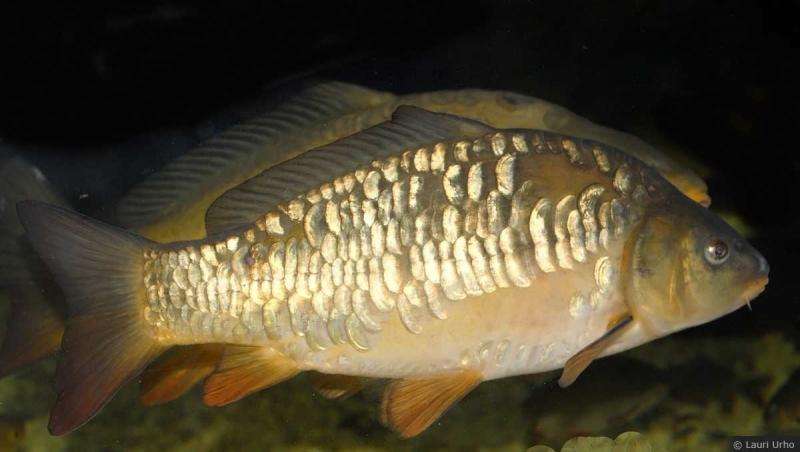Waterbirds threatened by invasive carp

The presence of the carp, a freshwater invasive species spread worldwide, is alarmingly reducing the populations of diving ducks and waterbirds, according to a study published in the journal Biological Conservation by Alberto Maceda Veiga from the University of Barcelona and Raquel López and Andy J. Green from the Doñana Biological Station (EBD-CSIC).
This is the first study which clearly shows the ecological impact of the carp on water birds in Mediterranean shallow lakes, and it warns about the dramatic effect of this invasive species on other species such as the white-headed duck (Oxyura leucocephala) and the red-crested pochard (Aythya farina), classified as endangered species by the International Union for Conservation of Nature (UICN).
The carp (Cyprinius carpio) is considered one of the most threatening alien exotic species worldwide, according to the UICN. This species, from the European and Asian continents, is included in the Spanish Catalog of Exotic Invasive Species and can live in a wide range of habitats, even the most degraded ones. Quite valued in sport fishing and aquaculture, the carp causes well-known ecological impacts in several countries, but there is a lack of studies on the effects on some organisms such as water birds.
The authors have studied the natural reserves in the lakes of Medina (Cadiz) and Zoñar (Cordoba) in Andalusia. These shallow depths are quite emblematic in the south of the Iberian Peninsula and are areas where many water birds hibernate—one of the reasons why the Board of Andalusia tried to eradicate the carp.
According to first author Alberto Maceda Veiga, member of IRBio and expert in the Doñana Biological Station (EBD-CSIC), "Fishermen value the carp, and since it has been found around the peninsula for a while, some people think it is an indigenous species. Therefore, studies like this one are important, because they clearly show the ecological impact in our ecosystems to raise awareness among people regarding the ecological problems caused by the invasion of the carp."
"The shallow lakes such as the ones in Medina and Zoñar are important lacustrine systems for the preservation of aquatic biodiversity in semi-arid regions such as the Mediterranean. Our scientific study concludes that there would be a severe impact on many water bird populations if all lakes were invaded by this exotic species," says Maceda.
An exotic species that alters aquatic habitats
This exotic invasive species is likely to live in calm waters rich in natural nutrients or which are derived from polluted waters (for example, fertilisers from agriculture). However, the nutrition of the carp alters the natural dynamics of these lakes to such an extent that it can eradicate the carpet plants, traits of these lacustrine environments.
For the first time, the new study describes in detail the biological impacts on birds that use the water, including omnivorous species (such as diving ducks) and vegetarians (coots). Since the carp eradicates aquatic plants, it also ends with many invertebrates that use those as shelter and which are food for the birds. Also, the carp is a predator of marine invertebrates. The ecological impact is lower for species such as the mallard. On the other hand, piscivorous species are organisms that can benefit from the invasion of the carp.
"The carp excavates and breaks aquatic plants while eating. Also, the sand it has moved during this process ends up on the plants and kills them. Directly or indirectly, as a final result, the plant carpet disappears," says Alberto Maceda.
"In this context, it is expected that short and soft winters such as the ones in the south of the peninsula and the effects that come from the climate change strengthen the ecological impact of the carp, which will be active during a longer time over the year."
How to avoid the ecological impact of the carp?
The new article, published in the journal Biological Conservation, reviews a wide period of time that includes two invasion cycles of the carp in the lake of Medina—the widest in the province of Cadis and second in Andalusia, counting with all the present birds. Including a long temporary margin that includes two invasion cycles prevents the bias caused by yearly demographical changes or late responses from the community of unnoticed organisms.
"The carp is an ecological problem for our territory and its populations should be controlled. Manipulating environmental conditions which make it easier for the carp to spread is a possibility to reduce the grouping and dispersal of this invasive species. However, when the invasion is not localized, the most efficient protocol is to use fishnets or electrofishing. The population of carps should certainly be controlled using ethical protocols of animal welfare and of management of the corresponding biological waste," conclude the authors.
More information: Alberto Maceda-Veiga et al. Dramatic impact of alien carp Cyprinus carpio on globally threatened diving ducks and other waterbirds in Mediterranean shallow lakes, Biological Conservation (2017). DOI: 10.1016/j.biocon.2017.06.002
Journal information: Biological Conservation
Provided by University of Barcelona












